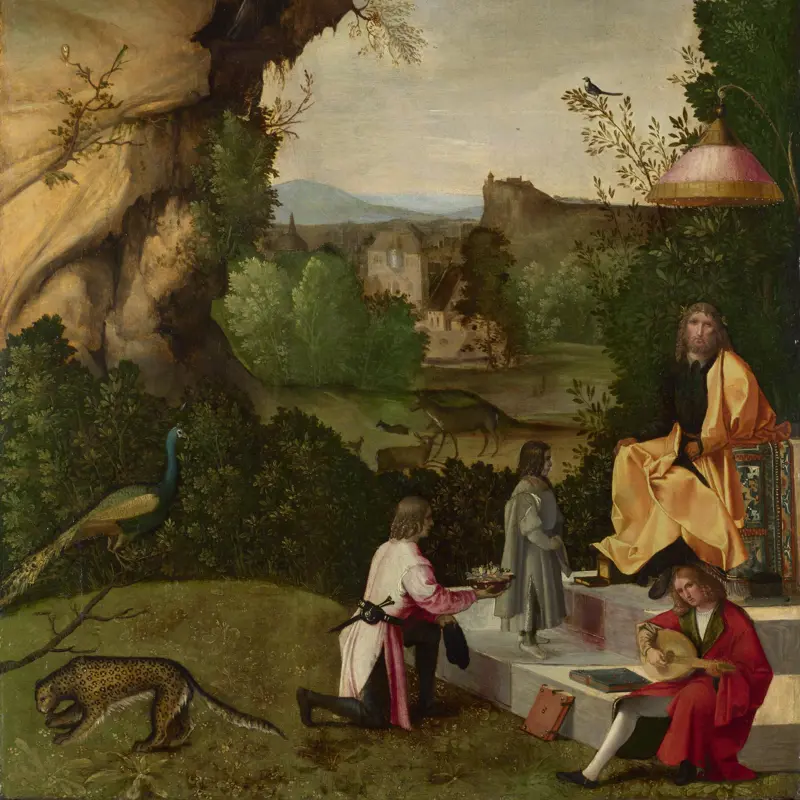Giorgione, 'The Adoration of the Kings', 1506-7
About the work
Overview
The shape and subject matter of this picture suggest that it was possibly painted as part of the predella (or lower part) of an altarpiece, although predellas were already rare in Venetian art during Giorgione’s lifetime.
The Virgin, Child and Saint Joseph are sitting on the steps of the stable where Christ has been born. The Three Kings have brought gifts to present to Christ, and kneel at a slight distance from the holy family. Caspar has already given his glass casket of myrrh to Joseph; the oldest king, Melchior, is about to present a golden bowl. Balthasar, the youngest king, kneels further away holding a glass orb that probably contains frankincense. The attendants wear exotic costumes and turbans, recalling their origins in the East. This painting is part of the so-called Allendale Group (after the Allendale Adoration of the Shepherds in the National Gallery of Art, Washington), paintings from earlier in Giorgione’s career which form the cornerstones of our understanding of his work.
Key facts
Details
Provenance
Additional information
Text extracted from the ‘Provenance’ section of the catalogue entry in Cecil Gould, ‘National Gallery Catalogues: The Sixteenth Century Italian Schools’, London 1987; for further information, see the full catalogue entry.
Exhibition history
-
2012Titian's First Masterpiece: The Flight Into EgyptThe National Gallery (London)4 April 2012 - 19 August 2012
Bibliography
-
1854G.F. Waagen, Treasures of Art in Great Britain: Being and Account of the Chief Collections of Paintings, Drawings, Sculptures, Illuminated Mss. […], vol. 2, trans. E. Eastlake, London 1854
-
1871J.A. Crowe and G.B. Cavalcaselle, A History of Painting in North Italy: Venice, Padua, Vicenza, Verona, Ferrara, Milan, Friuli, Brescia, from the Fourteenth to the Sixteenth Century, 2 vols, London 1871
-
1892G. Morelli, Italian Painters: Critical Studies of Their Works, 2 vols, London 1892
-
1897B. Berenson, The Venetian Painters of the Renaissance, with an Index to their Works, 2nd edn, New York 1897
-
1907H.F. Cook, Giorgione, London 1907
-
1909C.J. Holmes, 'The School of Giorgione at the Grafton Galleries', The Burlington Magazine, XVII/80, 1909, pp. 72-4
-
1909C. Phillips, 'Some Figures by Giorgione', The Burlington Magazine, XIV/72, 1909, pp. 331-7
-
1912J.A. Crowe and G.B. Cavalcaselle, A History of Painting in North Italy: Venice, Padua, Vicenza, Verona, Ferrara, Milan, Friuli, Brescia, from the Fourteenth to the Sixteenth Century, ed. T. Borenius, 2nd edn, 3 vols, London 1912
-
1913L. Venturi, Giorgione e il Giorgionismo, Milan 1913
-
1923C. Holmes, '"Giorgione" Problems at Trafalgar Square, II', The Burlington Magazine, XLII/242, 1923, pp. 230-9
-
1926H.F. Cook, 'Dr Justi on Giorgione', The Burlington Magazine, XLVIII/279, 1926, pp. 311-2
-
1926H.F. Cook, 'A Giorgione Problem', The Burlington Magazine, XLVIII/274, 1926, pp. 23-4
-
1937G.M. Richter, Giorgio da Castelfranco, Called Giorgione, Chicago 1937
-
1942A. Morassi, Giorgione, Milan 1942
-
1948G. Fiocco, Giorgione, Bergamo 1948
-
1955L. Coletti, Tutta la pittura di Giorgione, Milan 1955
-
1955P. Della Pergola, Giorgione, Milan 1955
-
1959Gould, Cecil, National Gallery Catalogues: The Sixteenth Century Venetian School, London 1959
-
1968V. Lilli and P. Zampetti, L'opera completa di Giorgione, Milan 1968
-
1969T. Pignatti, L'opera completa di Giovanni Bellini, Milan 1969
-
1970M. Calvesi, 'La "morte di bacio": Saggio sull'ermetismo di Giorgione', Storia dell'arte, 7-8, 1970, pp. 179-233
-
1975C. Gould, Delaroche and Gautier: Gautier's Views on the 'Execution of Lady Jane Grey' and on other Compositions by Delaroche, London 1975
-
1979D. Sutton, 'Robert Langton Douglas, XXI: Giotto to Giorgione', Apollo, CX, 1979, pp. 1-56
-
1980C. Hornig, 'Unterzeichnungen Giorgiones', Pantheon, XXXVIII/1, 1980, pp. 46-9
-
1987Gould, Cecil, National Gallery Catalogues: The Sixteenth Century Italian Schools, London 1987
-
1987C. Hornig, Giorgiones Spätwerk, Munich 1987
-
1989M. Lucco, La pittura nel Veneto: Il Quattrocento, 2 vols, Milan 1989
-
1990S. Settis, Giorgione's 'Tempest': Interpreting the Hidden Subject, Cambridge 1990
-
1991C. Hope and J.R.J. van Asperen de Boer, 'Underdrawings by Giorgione and his Circle', in H. Verougstraete-Marcq (ed.), Le dessin sous-jacent dans la peinture: Colloque VIII, 8-10 septembre, 1989, Louvain 1991, pp. 127-40
-
1993A.P. Torrini, Giorgione: Catalogo completo dei dipinti, Florence 1993
-
1994S.J. Freedberg, 'The Benson Holy Family: A Reconsideration', in P. Rosenberg et al., Hommage à Michel Laclotte. Etudes sur la peinture du Moyen Age et de la Renaissance, Milan 1994, pp. 324-38
-
1995M. Lucco, Giorgione, Milan 1995
-
1996H. Anderson, Giorgione, peintre de la 'brièveté poétique'. Catalogue raisonné, Paris 1996
-
1996E. Guidoni, 'L'Adorazione dei Magi di Londra', in E. Guidoni, Studi su Giorgione e sulla pintura del suo tempo, Rome 1996, vol. 6, pp. 3-18
-
1998M. Sladek, 'Lapis angularis and lapis exilis: Giorgione und die persische Legende von den heiligen drei Königen', Wiener Jahrbuch für Kunstgeschichte, LI, 1998, pp. 77-103
-
1999E. Guidoni, Giorgione: Opere e significati, Rome 1999
-
1999T. Pignatti, Giorgione, New York 1999
-
1999G. Helke, 'Giorgione als Maler des Paragone', Jahrbuch des Kunsthistorischen Museums Wien, I, 1999, pp. 11-79
-
2001
C. Baker and T. Henry, The National Gallery: Complete Illustrated Catalogue, London 2001
-
2001P. Joannides, Titian to 1518: The Assumption of Genius, New Haven 2001
-
2002D. Bomford et al., Underdrawings in Renaissance Paintings (exh. cat. The National Gallery, 30 October 2002 - 16 February 2003), London 2002
-
2002E. Guidoni, 'L'eresia segreta di Giorgione', Civiltà del Rinascimento, II/2, 2002, pp. 58-65
-
2007W. Eller, Giorgione: Catalogue Raisonné: Mystery Unveiled, Petersberg 2007
-
2008M. Hochmann, 'Le dessin dans la peinture vénitienne: Nouvelles recherches', Revue de l'art, 160, 2008, pp. 11-22
-
2009E.M. Dal Pozzolo and L. Puppi (eds.), Giorgione (exh. cat., Museo Casa Giorgione, Castelfranco Veneto), Milan 2009
-
2009E.M.D. Pozzolo et al., Giorgione (exh. cat. Museo Casa Giorgione, 12 December 2009 - 11 April 2010), Milan 2009
About this record
If you know more about this work or have spotted an error, please contact us. Please note that exhibition histories are listed from 2009 onwards. Bibliographies may not be complete; more comprehensive information is available in the National Gallery Library.




